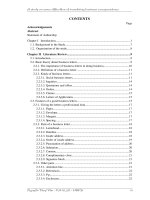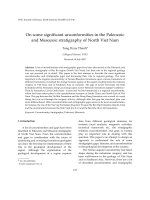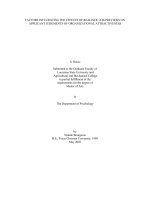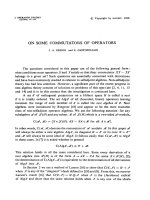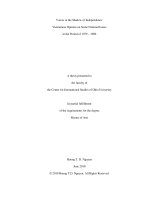On some implementations of solving the resource constrained project scheduling problems
Bạn đang xem bản rút gọn của tài liệu. Xem và tải ngay bản đầy đủ của tài liệu tại đây (320.96 KB, 11 trang )
natbib.sty
Yugoslav Journal of Operations Research
xx (2017), Number nn, zzz–zzz
DOI: />
ON SOME IMPLEMENTATIONS OF SOLVING
THE RESOURCE CONSTRAINED PROJECT
SCHEDULING PROBLEMS
E.Kh. GIMADI
Sobolev Institute of Mathematics, Novosibirsk, Russia
E.N. GONCHAROV
Sobolev Institute of Mathematics, Novosibirsk, Russia
D.V. MISHIN
Sobolev Institute of Mathematics, Novosibirsk, Russia
Received: November 2017 / Accepted: September 2018
Abstract: We consider the resource-constrained project scheduling problem with respect to the makespan minimization criterion. The problem accounts for technological
constraints of activities precedence together with resource constraints. Activities preemptions are not allowed. The problem with renewable resources is NP-hard in the strong
sense. We propose an exact branch and bound algorithm for solving the problem with
renewable resources. It uses our new branching scheme based on the representation of a
schedule in the form of an activity list. We use two approaches of constructing the lower
bound. We present results of numerical experiments illustrating quality of the proposed
lower bounds. The test instances are taken from the library of test instances PSPLIB.
Keywords: Project management, Resource constrained project scheduling problem,
Renewable resources, Cumulative resources, Branch and bound algorithms, PCPLIB.
MSC: 90B35, 90C27, 90C59.
1. INTRODUCTION
We consider the resource constrained project scheduling problem (RCPSP)
with precedence and resource constraints. The RCPSP can be defined as a combinatorial optimization problem. A partial order on the set of activities is defined
with a directed acyclic graph. For every activity, we know its duration, the list
of resources required for its completion, and the amount of consumed resources.
The resources are assumed to be unbounded outside the project horizon Tˆ. Activities preemptions are not allowed. The objective is to schedule the activities of
a project so as to minimize the project makespan.
According to the classification scheme proposed in [11], this problem is denoted as m, 1|cpm|Cmax . As a generalization of the job-shop scheduling problem
the RCPSP is NP-hard in the strong sense [2] and is actually one of the most
intractable classical problems in practice. It is worth noting that introducing of
cumulative resources into this problem, makes it solvable with polynomial complexity [8]. A remarkable example a practically applied algorithm for solving this
2
E. Gimadi, et al. / On Some Implementations of Solving the RCPSP
the construction of effective lower and upper bounds for non-truncated solutions,
where lower bound is more important. In most of the cases lower bounds for
the optimal solution can be calculated by relaxing some of the constraints and
obtaining an exact solution for the relaxed problem. We will use two approaches
to construct lower bounds. The first approach is to find the lower bound by
relaxing the resource renewability condition to resource cumulativeness. After
that, we solve the resulting relaxed problem and get an exact solution using the
polynomial algorithm from [8]. The second approach is to use a relaxation of
the original problem, in which each activity is replaced by a chain of activities of
unit duration. Note that the number of activities in such chain is equal to the
duration of the initial activity (all activities have integer duration). Resources
remain renewable. To solve this relaxed problem, we apply the algorithm [15].
The proposed lower bound algorithms were tested on instances from the electronic library PCPLIB. Both methods of calculating the lower bound are compared, and sets of instances, out of series of instances of J60 with sixty activities,
are revealed on which the proposed algorithms show their strength.
Another approach to solve the problem is to use metaheuristics. E.Goncharov
proposed a genetic algorithm with two versions of the crossover [10]. Each crossover
creates an offspring according to the criterion of optimisation of available resources.
Both crossovers use heuristic rules to find promising segments of parent chromosomes for their subsequent use in the offspring. This rule is based on finding the
scarcity of the resources, which, in turn, we can obtain from solutions of the relaxed
problem while replacing the renewability feature with the cumulativity feature for
constrained resources. To solve the relaxed problem, we use the known fast approximate algorithm [7]. Competitiveness this genetic algorithm was demonstrated by
our numerical experiments. We have found the best solutions for 9 instances from
the dataset j120, and the best average deviation from the critical path lower bound
for the datasets j60 (50000 and 500000 iterations) and j120 (500000 iterations).
In addition, we developed two other metaheuristics: local search algorithm and
hybrid algorithm. The hybrid algorithm uses the branch and bound scheme presented in this article, as well as elements of the genetic algorithm. The abovementioned algorithms allowed authors to find the best (previously unknown) solutions
for 15 instances (at the time of writing of this paper) with 120 activities from the
PSPLIB library. These results will be printed separately.
The remainder of the paper is organized as follows: Section 2 describes a general
problem setting for the RCPSP. A description of the subproblem with cumulative
resources is given in Section 3. Section 4 describes the subproblem with renewable
resources. Section 5 contains the detailed and comparative performance tests on
the benchmark datasets. The conclusions of this study are given in Section 6.
2. PROBLEM SETTING
The RCPSP problem can be defined as follows. A project is taken as a directed
acyclic graph G = (N, A). We denote by N = {1, ..., n} ∪ {0, n + 1} the set of activities in the project where activities 0 and n + 1 are dummy. The latter activities
E. Gimadi, et al. / On Some Implementations of Solving the RCPSP
3
define the start and the completion of the project respectively. The precedence
relation on the set N is defined with a set of pairs A = {(i, j) | i – precedes j}. If
(i, j) ∈ A, then activity j cannot start before activity i has been completed. The
set A contains all pairs (0, j) and (j, n + 1), j = 1, ..., n.
The activities use renewable and cumulative (or consume nonrenewable) resources. The sets of renewable and cumulative resources are denoted by Kρ and
Kν , respectively. For each renewable resource k ∈ Kρ , Rkρ (t) units are available at time t. For each cumulative resource k ∈ Kν , Rkν (t) units of resource
of type k are arrived at time t and can be consumed at any time t1 ≥ t. An
arbitrary activity j has deterministic duration pj ∈ Z + and requires rjk (τ )
0
units of resource of type k, k ∈ Kρ Kν at time τ = 1, ..., pj . We assume that
rjk (t) Rkρ (t), j ∈ N, k ∈ Kρ , t = 1, ..., Tˆ. The duration of dummy activities 0
and n + 1 is zero, while other activities (we call them real) have nonzero durations.
Moreover, dummy activities have zero resource consumption. Deadlines dj ∈ Z+
are specified for all j ∈ Ndir ⊂ N .
Now, we introduce the problem variables. We denote by sj
0 the starting
time of activity j ∈ N . Since activities are executed without preemptions, the
completion time of activity j is equal to cj = sj + pj . We define a schedule S as an
(n + 2)-vector (s0 , ..., sn+1 ). The completion time T (S) of the project corresponds
to the moment when the last activity n + 1 is completed, i.e., T (S) = cn+1 . We
denote by J(t) = {j ∈ N | sj < t cj } the set of activities which are executed in
the unit time interval [t − 1, t) under schedule S. The problem is to find a feasible
schedule S = {sj } respecting the resource, precedence and deadlines constraints
so that the completion time of the project is minimized. It can be formalized as
follows: minimize the makespan of the project
Cmax (S) = max(sj + pj )
(1)
j∈N
under constraints
sj + pj ≤ dj ,
j ∈ Ndir ;
(2)
si + pi ≤ sj ,
∀(i, j) ∈ A;
(3)
rjk (t − sj ) ≤ Rkρ (t), k ∈ Kρ , t ∈ Z+ \ {0};
(4)
j∈A(t)
t
t
Rkν (t ),
rjk (t − sj ) ≤
t =1 j∈J(t )
sj ∈ Z+ ,
k ∈ Kν , t ∈ Z+ \ {0};
(5)
t =1
j ∈ N.
(6)
The set of constraints (2) guarantees compliance with the deadlines. Inequalities (3) define activities precedence constraints. Relations (4) – (5) ensure compliance with constraints on renewable and cumulative resources, respectively: the
total amount of resource of type k consumed by all activities which are executed
4
E. Gimadi, et al. / On Some Implementations of Solving the RCPSP
during the unit time interval [t - 1,t) must not exceed the amount of resource
available at that interval. Finally, (6) defines the variables in question.
The problem (1)–(6) is known to be NP-hard if Kρ = ∅.
3. PROBLEM WITH CUMULATIVE RESOURCES
We consider a specific case of the problem (1)–(6) where Kρ = ∅ [8]. This case
is denoted by P S ν .
Let T be a positive integer. The solution S T = {sTj | j ∈ N } is called a T -late
schedule if all sTj are maximised under constraints (2), (3), (6) and
sTj + pj ≤ T,
j ∈ N.
The following notations are used: Qk (t) is the total amount of resource k ∈ Kν
available at time t; RkT (t) is the total amount of resource k ∈ Kν required by time t
in schedule S T ; ∆(T ) = min{∆ ∈ Z+ | RkT (t) ≤ Qk (t + ∆); t = 1, . . . , T ; k ∈ Kν }.
It is clear that T -late schedule S T is feasible respecting constraints (5) if and
only if ∆(T ) = 0.
We put T = Tcr + D, where
Tcr is the critical time of the project (calculated without resource constraints);
D is the maximum deadline (later on, D denotes the length of the binary encoding
of D);
∆min = min{∆ ∈ Z+ | RkT (t) ≤ Qk (t + ∆); t = 1, . . . , D; k ∈ Kν }.
It is clearly, that ∆min ≤ ∆ = ∆(T ).
We denote by Sopt the optimal schedule of P S ν .
Theorem 1. A consideration of P S ν can be split into three special cases.
1. If ∆min > 0 or ∆ = ∞, there is no solution for P S ν .
2. If ∆min = 0 and 0 < ∆ < ∞, the optimal schedule Sopt = {sj | j ∈ N } can be
computed as follows:
sj =
sTj
, for
sTj + ∆ , for
j ∈ Ndir ;
j ∈ N \ Ndir ,
where Ndir is the set of deadline-dependent activities.
Moreover, Cmax (Sopt ) = T + ∆.
3. If ∆ = 0, we have Tcr ≤ Cmax (Sopt ) ≤ T , and the optimal solution can be found
in O(D) iterations: at each iteration, the T -late schedule is computed for some
T ∈ {Tcr , . . . , T }, and the feasibility of the schedule is checked. In other words, the
optimal solution is found by the binary search.
Theorem 2. The optimal solution for P S ν can be found in
O(D(u + I + I log f |K|) + |Ndir | log Nd )
E. Gimadi, et al. / On Some Implementations of Solving the RCPSP
5
time, where u is the number of arcs of the reduction graph;
I is the total (over all resources k ∈ Kν ) number of constancy intervals of functions
Rkν (t);
I is the total (over all resources and all activities) number of constancy intervals
of functions rjk (t);
f is the width of the partial order;
|K| is the number of constrained resources;
|Ndir | is the number of activities with given deadlines;
Nd is the number of various deadlines.
It will be interesting to establish polynomial solvability of the problem considered
under assumption that intensities Rkν (t) of given cumulative resources can be both
positive or negative.
4. PROBLEM WITH RENEWABLE RESOURCES
Now we consider another specific case of the problem (1)–(6), where Kν = ∅
and Ndir = ∅. This problem is denoted by P S ρ .
We have a set of renewable resources K, for each resource type k ∈ K there is
a constant availability Rk ∈ Z + throughout the project horizon Tˆ. Activity j has
deterministic duration pj ∈ Z + . The profile of resource consumption is assumed
to be constant for every activity. So, activity j requires rjk 0 units of resource
of type k, k ∈ K at every time instant when it is processed. We assume that
rjk
Rk , j ∈ N, k ∈ K. The problem is to find a feasible schedule S = {sj }
that minimizes the completion time of the project T (S), and can be formalized as
follows: minimize the makespan of the project
T (S) = max(sj + pj )
j∈N
(7)
under constraints
si + pi ≤ sj ,
rjk
∀(i, j) ∈ A;
Rk , k ∈ K, t = 1, ..., Tˆ;
(8)
(9)
j∈J(t)
sj ∈ Z+ ,
j ∈ N.
(10)
Inequalities (8) define activities precedence constraints. Relation (9) corresponds
to the resource constraints. Finally, (10) defines the variables in question.
4.1. A GENERAL DESCRIPTION OF THE BRANCH-AND-BOUND ALGORITHM
We represent a feasible solution as an activity list [12]. A feasible solution is
encoded by the list of activities L = (j0 , ..., jn+1 ). All lists under consideration are
assumed to be compatible with the precedence relations. For an arbitrary list L,
6
E. Gimadi, et al. / On Some Implementations of Solving the RCPSP
the serial decoding procedure (S-SGS) calculates the active schedule S(L) [12]. It is
known that there is an optimal schedule among the active schedules. A schedule
is called active if the starting times of the activities are such that no activity
can be started earlier its starting time without violating precedence condition
and resource constraints. The parallel decoder (P-SGS) sequentially considers
increasing moments of time, and schedules a subset of the eligible activities to
start at this moment for each of them.
By a partial solution we mean an ordered list Lp of p activities, p < n , also
satisfying the pre-activity relation in this list.
An unsealed vertex ν in the branch tree Ω provides two sets: ordered set Lν is
a partial solution, and unordered set Dν is the set of vertices from the set N \Lν
whose all predecessors have been scheduled up.
While examining the vertex ν in the branch tree, we perform the following
actions. We apply S-SGS decoder to the partial solution Lν and calculate the active
schedule S(Lν ), and subsequently find the earliest starting times of activities and
the total completion time Tp (S(Lν )) (considering the resource constraints). Then
for all activities from the set Dν , guided by these early times of their immediate
predecessors, we assign the minimum to their starting times and calculate the
lower bound LB(Sν ) for the network with the set of activities N \Lν .
Let T ∗ be the minimum of the objective function found at this moment, we
call it a record value, or simply a record. If LB(Sν ) > T ∗ , then the vertex is cut
off, which means that it is removed from the branch tree Ω, and we pass to the
next step of the branch and bound algorithm. Otherwise, we calculate the upper
bound U B(Sν ) and if T (Sν ) < T ∗ , then we change the record. If the record has
been changed, we scan all the unsealed vertices in Ω and cut off those whose lower
bound is greater than the new record. After that, we modify the branch tree Ω as
follows: if the set Dν is not empty, then one of the activities of this set is added to
the end of the list Lν , the corresponded vertex is deleted from the set Dν , and we
add to Dν those activities from N \Lν , for which all their immediate predecessors
belong to the modified list Lν . If the set Dν is empty, then no new vertex is added
to the tree. At the first step of the algorithm, we assume Lν = ∅ and Dν contains
all the activities from the original set of activities N that do not have predecessors.
Lower bounds. We propose two methods for calculating the lower bound. In
the first, we use the solution of a relaxed problem with cumulative resources, and
in the second, we use the relaxation of the original problem in which the resources
remain renewable, and replace each activity of integer duration by a chain of unit
duration activities.
Lower bound A (LB-A). We consider the RCPSP problem, but instead of constraint (9), we introduce another constraint, were resources are cumulative:
t
t
rjk ≤
t =1 j∈A(t )
Rk ,
k ∈ K, t = 1, ..., Tˆ.
(11)
t =1
In [8], it was proved that finding an exact solution of the problem (7) – (8), (10) –
(11) is possible in polynomial time, and an algorithm for solving the problem was
E. Gimadi, et al. / On Some Implementations of Solving the RCPSP
Classes
1
2
3
4
5
6
n
15
15
15
15
15
15
|K|
4
4
4
4
4
4
AR
6–10
6–10
6–10
6–10
6–10
6–10
CR(% from AR) SA
10–30
1–2
10–30
2–4
30–60
1–2
30–60
2–4
60–90
1–2
60–90
2–4
7
pj
1-4
1-4
1-4
1-4
1-4
1-4
Table 1: Parameters of instances classes
presented (see Section 3).
Lower bound B (LB-B). We consider the problem P |prec, pj = 1|Cmax , a relaxation of (7) – (10), where all activities have unit duration. To achieve this, we
divide each activity of duration pj into a chain of pj activities of unit duration.
The resource renewability property is preserved. This problem is NP-hard in the
strong sense [18]. Servakh [15] developed an algorithm for solving this problem,
based on the idea of dynamic programming, which is exponential in the width of
the partial order. The optimal solution for this problem can be found in
|C|
O(n5/2 + 2|C| |C||K|
(Sk + 1)
k=1
time, where C is the set of disjoint chains in graph G,
Sk is the total duration of chain k = 1, ...|C|,
n
n = j=1 pj .
To find the upper bound, we will use the greedy algorithm [9]. Advantages
of the this algorithm are relatively high quality of the obtained solutions and low
time complexity, n2 log n dependency from the number of activities.
5. COMPUTATIONAL EXPERIMENTS
The quality of the proposed lower bounds were tested in a series of numerical
experiments. To compare the lower bounds, a graph generator was implemented.
Instances were created in the same form as in the PSPlib library [13]. We considered the following parameters as inputs for generating graphs: the number of
activities (n) and resource types (|K|), the amount of allocated resources (AR),
the amount of consumed resources (as a percentage of the amount of allocated resources, CR), the durations of activities pj and the number of successor-activities
(SA). For parameters AR, CR, SA, and pj , we use a random value between the
minimum and maximum number. The instances were divided into 6 classes. Table
1 shows the parameters of these classes.
The obtained classes were used to test the effectiveness of finding lower bounds.
1000 instances for each class were generated. For each instance the lower bounds
were calculated and the average error between them was derived. The average
values of the lower bounds of algorithm A were then taken as 100% watermark,
and values obtained by algorithm B — as the percentage of the first algorithm.
The result of comparing the two lower bounds is shown in Table 2.
8
E. Gimadi, et al. / On Some Implementations of Solving the RCPSP
Average width
Classes LB-A, % LB-B, % of the partial order
1
100
100,31
4,59
2
100
100,12
4,00
3
100
114,97
4,51
4
100
112,30
3,97
5
100
122,62
4,64
6
100
123,25
3,90
Average CPU-time (s)
LB-A
LB-B
0,001
4,59
0,001
4,00
0,001
4,51
0,001
3,97
0,001
4,64
0,001
3,89
Table 2: Comparing lower bounds A and B
As we can see in Table 2, for instances where each activity consumes 10-30% of
the allocated resources on average, it is more efficient to use the RCPSP solution
with the cumulative resources (LB-A), since the error between bounds is extremely
small (classes 1-2), and this algorithm is polynomial. For instances where the
activity consumes on average more than 30% of allocated resources (classes 37), it is recommended to use the LB-B algorithm, since it finds a more accurate
solution. We note, however, that it is time consuming to use the LB-B algorithm
for large dimensions due to the exponential complexity of the algorithm. Average
CPU-time for the algorithm LB-A is about 0,001 second for all classes of instances,
and for algorithm LB-B — a few seconds. All experiments were conducted on a
PC with 3.4 GHz CPU and 8 Gb RAM under the operating system Windows 7.
The next series of numerical experiments were carried out directly on the instances from the PSPlib library. Two datasets of test instances were used: J30
and J60. Each of these sets contains 48 series of instances, 10 instances in each
series, 480 instances in total. For the instances from dataset J30 exact solutions
are known, they are provided in PSPlib. For each series, the average deviations
from the exact solution of the lower bounds obtained by the critical path method
(columns 2 and 6 of Table 3), the lower LB-A bounds (columns 3 and 7), and the
average deviations from the exact solution of the upper UB bounds (columns 4
and 8) were found. The average deviation of the lower bound of LB-A from the
exact solutions for all 480 instances is -7.66%, while average deviation of Tcr is
-9.21%. The average deviation of the upper bound UB from the exact solutions
is 3.46%. The average deviations for each of the 48 series are shown in Table 3.
Worth noting is that the series of instances in PSPlib have different complexity,
and the LB-A algorithm had a significant advantage over the algorithm based on
the critical path method on complex series.
In Table 4 similar results are provided for the set J60 of instances with 60
activities, albeit with one difference: for these instances exact solutions are unknown, and comparisons were made with the best known solutions. The average
deviation of the lower LB-A bound from the best solutions on the dataset J60
is -4.37% (-7.03% for Tcr), and the average deviation of the upper UB bound is
3.75%.
We can identify instances where lower bound LB-A is better than lower bound
LB-Tcr. The average deviations of LB-A for such instances were marked in bold
in Tables 3 and 4.
9
E. Gimadi, et al. / On Some Implementations of Solving the RCPSP
Instances Dev.
% Dev.
LB=Tcr
LB-A
J30 1
-11,55
-11,55
J30 2
-4,03
-4,03
J30 3
-2,86
-2,86
J30 4
0
0
J30 5
-27,21
-24,46
J30 6
-6,86
-6,86
J30 7
-3,51
-3,51
J30 8
0
0
J30 9
-33,09
-26,30
J30 10
-5,01
-5,01
J30 11
-1,33
-1,33
J30 12
0
0
J30 13
-36,49
-19,14
J30 14
-6,30
-5,92
J30 15
-1,15
-1,15
J30 16
0
0
J30 17
-11,65
-11,49
J30 18
-7,74
-7,74
J30 19
-2,64
-2,64
J30 20
0
0
J30 21
-25,67
-24,00
J30 22
-7,25
-7,25
J30 23
-2,41
-2,41
J30 24
0
0
% Dev. % UB Instances
2,66
0,58
0,82
0
10,44
5,02
1,59
0
10,89
4,00
1,64
0
11,25
6,16
0,52
0
6,41
3,72
1,01
0
7,67
1,09
2,57
0
J30
J30
J30
J30
J30
J30
J30
J30
J30
J30
J30
J30
J30
J30
J30
J30
J30
J30
J30
J30
J30
J30
J30
J30
25
26
27
28
29
30
31
32
33
34
35
36
37
38
39
40
41
42
43
44
45
46
47
48
Dev.
% Dev.
LB=Tcr
LB-A
-36,69
-25,14
-3,43
-3,43
-0,61
-0,61
0
0
-41,56
-22,75
-8,88
-8,88
-2,66
-2,66
0
0
-11,97
-11,97
-4,81
-4,81
-1,92
-1,92
0
0
-29,70
-28,57
-7,18
-7,18
-4,01
-4,01
0
0
-37,24
-31,69
-6,39
-6,39
-1,71
-1,71
0
0
-36,52
-28,46
-7,08
-7,08
-2,82
-2,82
0
0
% Dev. % UB
13,89
4,06
0,23
0
11,85
4,89
0,95
0
1,27
1,22
0,20
0
10,71
2,52
0,34
0
7,63
2,98
4,12
0
14,26
4,74
2,03
0
Table 3: Average deviations from the exact solution for the dataset J30
Instances Dev.
% Dev.
LB=Tcr
LB-A
J60 1
-8,59
-8,59
J60 2
-2,26
-2,26
J60 3
-1,89
-1,89
J60 4
0
0
J60 5
-20,96
-17,65
J60 6
-0,68
-0,68
J60 7
0
0
J60 8
0
0
J60 9
-27,73
-14,79
J60 10
-0,15
-0,15
J60 11
0
0
J60 12
0
0
J60 13
-39,25
-9,72
J60 14
-1,02
-1,02
J60 15
0
0
J60 16
0
0
J60 17
-8,57
-8,57
J60 18
-0,77
-0,77
J60 19
-1,25
-1,25
J60 20
0
0
J60 21
-24,35
-21,55
J60 22
-1,69
-1,69
J60 23
-0,38
-0,38
J60 24
0
0
% Dev. % UB Instances
4,21
0,93
0,69
0
12,97
1,83
0
0
14,45
0,72
0
0
12,94
2,72
0
0
8,65
2,43
0,58
0
13,86
3,44
0
0
J60
J60
J60
J60
J60
J60
J60
J60
J60
J60
J60
J60
J60
J60
J60
J60
J60
J60
J60
J60
J60
J60
J60
J60
25
26
27
28
29
30
31
32
33
34
35
36
37
38
39
40
41
42
43
44
45
46
47
48
Dev.
% Dev.
LB=Tcr
LB-A
-31,43
-18,86
-2,01
-2,01
0
0
0
0
-39,05
-14,40
-3,11
-3,11
0
0
0
0
-9,29
-9,29
-2,18
-2,18
-1,27
-1,27
0
0
-24,69
-21,48
-1,66
-1,66
-0,12
-0,12
0
0
-34,47
-21,05
-2,82
-2,82
-0,13
-0,13
0
0
-40,52
-15,68
-4,96
-4,96
0
0
0
0
Table 4: Average deviations from the heuristic solution for the dataset J60
% Dev. % UB
14,84
3,15
0
0
14,02
4,33
0
0
4,00
3,08
1,90
0
15,25
4,47
0,24
0
11,46
3,00
0
0
13,54
6,11
0,45
0
10
E. Gimadi, et al. / On Some Implementations of Solving the RCPSP
6. CONCLUSIONS and SUGGESTIONS
We considered the resource constrained project scheduling problem (RCPSP)
with precedence and resource constraints. The problem accounts for technological
constraints of activities precedence together with resource constraints. Activities
preemptions are not allowed. We proposed the exact branch and bound algorithm
with a new branching scheme based on the presentation of a schedule in the form
of an activity list. We used two approaches of constructing the lower bound. The
results of numerical experiments are presented. A promising direction for further
research is the construction of a combined algorithm using branch and bound and
heuristic methods. It will be interesting to establish polynomial solvability of the
problem with cumulative resources considered under assumption that intensities
Rkν (t) of given cumulative resources can be both positive or negative.
Acknowledgement: This work was supported by the Russian Foundation for
Basic Research, project no. 16-07-00829 and 16-07-00168.
The authors would like to express our sincere gratitude to the anonymous
referee for helpful and detailed comments that have helped to improve the quality
of the manuscript.
REFERENCES
[1] Baptiste, P, Demassey, S, “Tight LP bounds for resource constrained project scheduling”,
OR Spectrum. (2004) V. 26 (2), P. 251-262.
[2] Bla˙zewicz, J, Lenstra, J.K., Rinnoy Kan, A.H.G., “Scheduling Subject to Resource Constraints: Classification and Complexity” Discrete Applied Math. (1983) V. 5. No. 1. P. 11–24.
[3] Brucker, P, Drexl, A, M¨
ohring, R, at al., “Resource-Constrained Project Scheduling: Notation, Classification, Models, and Methods”, Eur. J. Oper. Res (1999) V. 112. No 1. P. 3–41.
[4] Brucker, P, Knust, S, Schoo A,, Thiele, O, “A branch and bound algorithm for the resourceconstrained project scheduling problem”, European Journal of Operational Research, 107
(1998) 272–288.
[5] Tinggui Chen, Guanglan Zhou, “Research on Project Scheduling Problem with Resource
Constraints”, Journal of Software, (2013) V. 8, No. 8. P. 2058-2063.
[6] Demeulemeester, E, Herroelen, W, “ A branch and bound procedure for the multiple
resource-constrained project scheduling problem.” Management Science 38 (1992) 18031818.
[7] Gimadi, E.Kh., “On Some Mathematical Models and Methods for Planning Large-Scale
Projects, Models and Optimization Methods”, in Proc. AN USSR Sib. Branch, Math.
Inst., Novosibirsk: Nauka, (1988) vol. 10, pp. 89-115.
[8] Gimadi, E.Kh., Zalyubovskii, V.V., Sevastyanov, S.V., “Polynomial Solvability of Scheduling Problems with Storable Resources and Deadlines”, Diskretnyi Analiz i Issledovanie
Operfzii, Ser. 2, (2000), vol. 7, no. 1, pp. 9–34.
[9] Goncharov, E.N., “ Stochastic Greedy Algorithm for the Resource-Constrained Project
Scheduling Problem”, Diskret. Anal. Issled. Oper., (2014) vol. 21, no. 3, pp. 10–23.
[10] Goncharov, E.N., Leonov, V. V., “Genetic Algorithm for the Resource-Constrained Project
Scheduling Problem”, Automation and Remote Control, (2017) Vol. 78, No. 6, pp. 11011114.
E. Gimadi, et al. / On Some Implementations of Solving the RCPSP
11
[11] Herroelen, W, Demeulemeester, E, De Reyck, B, “A Classification Scheme for Project
Scheduling” Weglarz J. (Ed.). Project Scheduling-Recent Models, Algorithms and Applications, International Series in Operations Research and Management Science. Kluwer Acad.
Publish., Dordrecht (1998), V. 14. P. 77–106 (Chapter 1).
[12] Kolisch, R, Hartmann, S, “Heuristic Algorithms for Solving the Resource-Constrained
Project Scheduling Problem: Classification and Computational Analysis”, J. Weglarz, (ed).
Project scheduling: Recent models, algorithms and applications. Kluwer Acad. Publish.,
(1999) P. 147–178.
[13] Kolisch, R, Sprecher, A, “ PSPLIB-a Project Scheduling Problem Library”, Eur. J. Oper.
Res. (1997) V. 96. P. 205–216. (downloadable from />[14] Mingozzi, A, Maniezzo, V, Ricciardelli, S, Bianco, L, “An exact algorithm for the resourceconstrained project scheduling problem based on a new mathematical formulation”, Management Science, 44 (1998) 715–729.
[15] Servakh, V.V., “An effectively solvable case of a scheduling problem with renewable resources”, Diskret. Anal. Issled. Oper., Ser. 2, (2000) V. 7. No. 1. P. 75–82.
[16] Sprecher, A, “Scheduling Resource-Constrained Projects Competitively at Modest Resource
Requirements”, Management Sci. (2000) V. 46. P. 710–723.
[17] Stinson, J.P., Davis, E.W., Khumawala, B.M., “Multiple Resource-Constrained Scheduling
Using Branch and Bound”, AIIE Transactions, (1978) V. 10. P. 252-259.
[18] Ullman, J.D., “NP-complete scheduling problems”, J. Comput. System Sci. (1975) V. 10.
No.3. P. 284–393.
